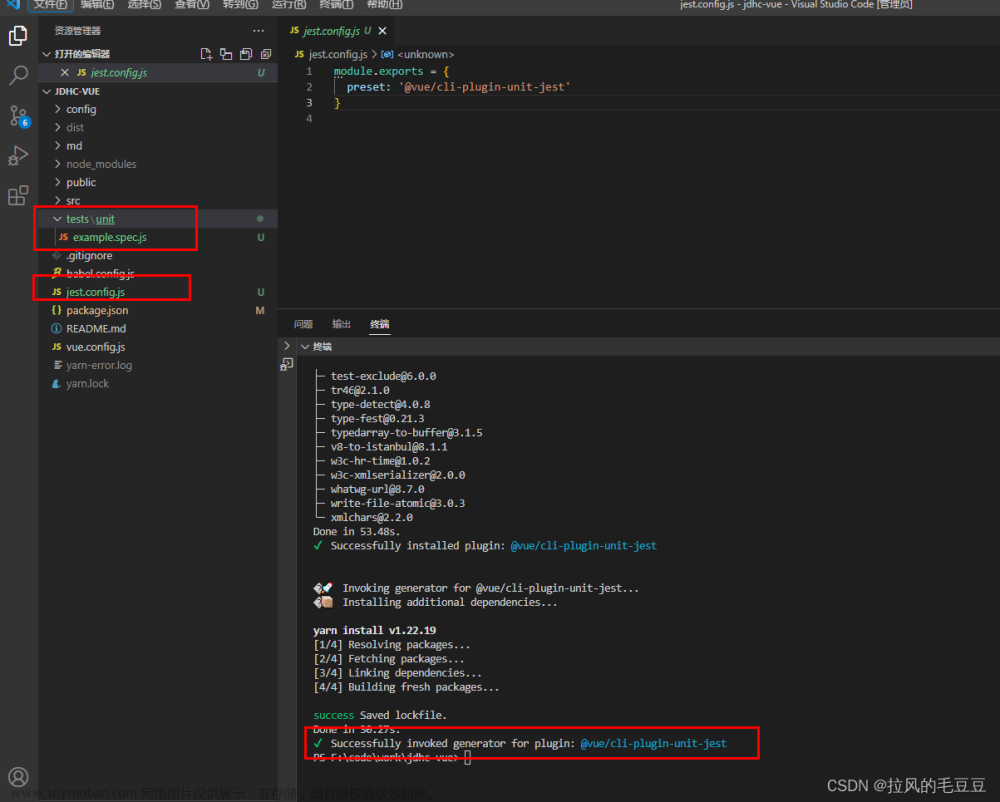安装及配置
- 安装相关库:
首先,使用npm或yarn安装所需的库。
npm install --save-dev jest enzyme enzyme-adapter-react-16 enzyme-to-json
- 配置Jest:
在项目根目录下创建一个jest.config.js文件,并配置Jest。
// jest.config.js
module.exports = {
setupFilesAfterEnv: ['<rootDir>/src/setupTests.js'],
testEnvironment: 'jsdom',
moduleNameMapper: {
'\\.(css|less)$': 'identity-obj-proxy',
},
};
在上述配置中,设置了setupFilesAfterEnv为src/setupTests.js,指定了测试环境为jsdom,并设置了模块名称映射以处理CSS和LESS文件。
- 创建
setupTests.js文件:
在项目的src目录下创建一个setupTests.js文件,并进行Enzyme的初始化和配置。
// src/setupTests.js
import Enzyme from 'enzyme';
import Adapter from 'enzyme-adapter-react-16';
Enzyme.configure({ adapter: new Adapter() });
在运行时可能会报错的一些全局事件,然后再上述的setupTests.js文件引入就行。
/**
* 各种全局变量报错
*/
// antd报错, 全局定义 window.matchMedia
if (!window.matchMedia) {
Object.defineProperty(window, 'matchMedia', {
configurable: true,
writable: true,
value: jest.fn(query => ({
matches: true,
media: query,
onchange: null,
addListener: jest.fn(), // Deprecated
removeListener: jest.fn(), // Deprecated
addEventListener: jest.fn(),
removeEventListener: jest.fn(),
dispatchEvent: jest.fn()
}))
});
}
export {};
在上述代码中,导入Enzyme和Enzyme适配器,并使用适配器初始化Enzyme。
- 编写测试用例:
在测试目录中创建一个与要测试的组件对应的测试文件,并编写测试用例。
import React from 'react';
import { mount } from 'enzyme';
import YourComponent from '../YourComponent';
describe('YourComponent', () => {
it('renders correctly', () => {
const component = mount(<YourComponent />);
expect(component.find('.your-class').text()).toBe('Hello World');
});
});
在上述代码中,使用mount方法来渲染组件,并使用Enzyme提供的API来查找组件中的元素,并进行断言验证。
- 运行测试:
在终端中运行测试命令,以执行测试用例。
npm run test
Jest将自动查找并执行项目中以.test.js或.spec.js结尾的文件中的测试用例。
enzyme渲染
Enzyme提供了三种常用的渲染方式,分别是shallow、mount和render。这些渲染方式在测试组件时具有不同的特点和用途。
-
shallow渲染:shallow渲染是Enzyme的浅层渲染方式,它仅渲染被测试组件本身,而不渲染其子组件。
import { shallow } from 'enzyme';
import YourComponent from '../YourComponent';
test('测试组件渲染', () => {
const wrapper = shallow(<YourComponent />);
// 对被测试组件进行断言和验证
});
使用shallow渲染时,被测试组件的子组件将被替换为占位符,并且无法直接访问子组件。这使得测试更加轻量且快速,适用于对被测试组件本身的行为进行测试。
-
mount渲染:mount渲染是Enzyme的全渲染方式,它会将被测试组件及其子组件完全渲染到真实的DOM中。这使得可以模拟实际的组件嵌套和交互,并对其进行全面的测试。
import { mount } from 'enzyme';
import YourComponent from '../YourComponent';
test('测试组件渲染', () => {
const wrapper = mount(<YourComponent />);
// 对被测试组件及其子组件进行断言和验证
});
使用mount渲染时,被测试组件及其子组件将在真实的DOM中进行渲染和交互。这使得可以测试组件的交互、生命周期方法和子组件的行为。
-
render渲染:render渲染是Enzyme的静态渲染方式,它将组件渲染为静态的HTML字符串,不涉及真实的DOM操作。这使得可以对组件的输出进行快照测试,以验证其渲染结果是否符合预期。
import { render } from 'enzyme';
import YourComponent from '../YourComponent';
test('测试组件渲染', () => {
const wrapper = render(<YourComponent />);
// 对组件输出的HTML进行断言和验证
});
使用render渲染时,被测试组件及其子组件将以静态HTML字符串的形式输出,可以方便地进行快照测试。
下面的例子中使用到的渲染方式只是举例,结合实际情况使用mount、shalldow或者render都是可以的。
测试技巧
一、常见测试
- 示例:测试组件渲染和属性传递
假设有一个简单的React组件Button,接收一个label属性,并在按钮上显示该标签。可以编写一个测试用例来验证组件是否正确渲染和传递属性。
import React from 'react';
import { shallow } from 'enzyme';
import Button from '../Button';
describe('Button', () => {
it('renders correctly with label prop', () => {
const label = 'Click me';
const wrapper = shallow(<Button label={label} />);
expect(wrapper.text()).toBe(label);
});
});
在上述例子中,使用shallow渲染方法来渲染Button组件,并使用expect和toBe断言验证按钮上的文本是否与传递的标签相匹配。
- 示例:模拟事件处理
假设有一个表单组件LoginForm,其中包含一个提交按钮。可以编写一个测试用例来模拟按钮点击事件,并验证相应的事件处理函数是否被调用。
import React from 'react';
import { mount } from 'enzyme';
import LoginForm from '../LoginForm';
describe('LoginForm', () => {
it('calls onSubmit handler on button click', () => {
const onSubmit = jest.fn();
const wrapper = mount(<LoginForm onSubmit={onSubmit} />);
wrapper.find('button').simulate('click');
expect(onSubmit).toHaveBeenCalledTimes(1);
});
});
在上述例子中,使用mount渲染方法来渲染LoginForm组件,并使用simulate方法模拟按钮的点击事件。然后,使用expect和toHaveBeenCalledTimes断言验证onSubmit函数是否被调用了一次。
- 示例:异步操作的处理
如果组件中包含异步操作,可以使用async/await或done回调函数来处理异步测试。
import React from 'react';
import { mount } from 'enzyme';
import AsyncComponent from '../AsyncComponent';
describe('AsyncComponent', () => {
it('renders data correctly after fetching', async () => {
const fetchData = () => {
return new Promise((resolve) => {
setTimeout(() => {
resolve('Data');
}, 1000);
});
};
const wrapper = mount(<AsyncComponent fetchData={fetchData} />);
expect(wrapper.text()).toBe('Loading...');
await Promise.resolve(); // 等待异步操作完成
wrapper.update();
expect(wrapper.text()).toBe('Data');
});
});
在上述例子中,使用await关键字等待异步操作的完成,并使用wrapper.update()手动更新组件,以便正确渲染异步操作后的数据。
二、触发ant design组件
使用Ant Design的组件时,可以通过模拟事件或直接调用组件的方法来触发各种操作。下面是一些常见组件的触发方法示例:
- Input 输入框:
import { mount } from 'enzyme';
import { Input } from 'antd';
test('触发Input输入', () => {
const wrapper = mount(<Input />);
// 模拟输入
wrapper.find('input').simulate('change', { target: { value: 'Hello' } });
// 模拟回车
wrapper.find('input').simulate('keydown', { keyCode: 13, which: 13 }
});
// 模拟失去焦点
test('模拟输入框失去焦点', () => {
const onBlur = jest.fn(); // 失去焦点时调用的函数
const wrapper = mount(<YourComponent onBlur={onBlur} />);
// 找到输入框元素,并触发失去焦点事件
wrapper.find('input').simulate('blur');
wrapper(onBlur).toHaveBeenCalled();
});
在上述例子中,使用simulate方法模拟输入框的change事件,并传递了一个模拟的event对象,其中target.value表示输入的值。
- Select 选择器:
import { mount } from 'enzyme';
import { Select } from 'antd';
test('直接调用Select方法更新选项', () => {
const wrapper = mount(
<Select>
<Select.Option value="option1">Option 1</Select.Option>
<Select.Option value="option2">Option 2</Select.Option>
</Select>
);
const selectInstance = wrapper.find('Select').instance();
// 更新选项
selectInstance.updateOptions([
{ value: 'option3', label: 'Option 3' },
{ value: 'option4', label: 'Option 4' },
]);
});
在上述例子中,使用 simulate 方法模拟点击下拉菜单按钮的 mousedown 事件,然后模拟点击第一个选项的 click 事件来选择该选项。
- Checkbox 复选框:
import { mount } from 'enzyme';
import { Checkbox } from 'antd';
test('触发Checkbox选择', () => {
const wrapper = mount(<Checkbox>Checkbox</Checkbox>);
wrapper.find('input').simulate('change', { target: { checked: true } });
});
在上述例子中,使用simulate方法模拟复选框的change事件,并传递了一个模拟的event对象,其中target.checked表示复选框的选中状态。
- Dropdown 下拉菜单:
import { mount } from 'enzyme';
import { Dropdown, Menu } from 'antd';
test('触发Dropdown菜单', () => {
const menu = (
<Menu>
<Menu.Item key="1">Option 1</Menu.Item>
<Menu.Item key="2">Option 2</Menu.Item>
</Menu>
);
const wrapper = mount(<Dropdown overlay={menu}><a href="#">Dropdown</a></Dropdown>);
wrapper.find('a').simulate('click');
});
在上述例子中,使用simulate方法模拟下拉菜单的触发事件,例如click事件。
- 模拟文件上传
在React中,由于安全性的限制,不能直接模拟文件上传的完整流程。但是,可以通过模拟触发change事件来模拟用户选择文件的行为。这样可以触发相应的文件上传逻辑。
以下是一个示例代码,演示了如何使用simulate方法来模拟文件上传:
import { mount } from 'enzyme';
test('模拟文件上传', () => {
const onFileUpload = jest.fn(); // 模拟文件上传时调用的函数
const wrapper= mount(<YourComponent onFileUpload={onFileUpload} />);
// 创建一个模拟的File对象
const file = new File(['文件内容'], 'filename.txt', { type: 'text/plain' });
// 创建一个模拟的事件对象,设置target.files为模拟的File对象
const event = {
target: { files: [file] },
};
// 找到文件上传的input元素,并触发change事件
wrapper.find('input[type="file"]').simulate('change', event);
expect(onFileUpload).toHaveBeenCalledWith(file);
});
在上述代码中,创建了一个模拟的File对象,并将其作为事件对象的target.files属性。然后,使用simulate方法触发了一个change事件,模拟文件选择的操作。最后,使用expect断言来验证回调函数onFileUpload是否被调用,并传递了模拟的文件对象作为参数。
这些是一些常见Ant Design组件的触发方法示例。根据具体的组件和需求,可以使用适当的方法来模拟事件触发或直接调用组件的方法。
三、使用redux组件
当编写涉及Redux的组件的单元测试时,可以采取以下措施以确保测试不会报错:
- 模拟Redux Store:
在测试中,可以创建一个模拟的Redux Store,并将其传递给组件作为属性。可以使用类似于redux-mock-store的库来创建模拟的Store。
import React from 'react';
import { shallow } from 'enzyme';
import configureMockStore from 'redux-mock-store';
import YourComponent from '../YourComponent';
const mockStore = configureMockStore();
const initialState = {
// 初始状态
};
const store = mockStore(initialState);
describe('YourComponent', () => {
it('renders without errors', () => {
const wrapper = shallow(<YourComponent store={store} />);
expect(wrapper).toBeTruthy();
});
});
在上述例子中,使用redux-mock-store库创建了一个模拟的Store,并将其传递给YourComponent作为属性。
- 使用Provider组件:
在测试中,使用Redux的Provider组件将模拟的Store包装在组件的外部。这样可以确保组件在测试中能够访问到Redux的状态和行为。
import React from 'react';
import { shallow } from 'enzyme';
import { Provider } from 'react-redux';
import configureMockStore from 'redux-mock-store';
import YourComponent from '../YourComponent';
const mockStore = configureMockStore();
const initialState = {
// 初始状态
};
const store = mockStore(initialState);
describe('YourComponent', () => {
it('renders without errors', () => {
const wrapper = shallow(
<Provider store={store}>
<YourComponent />
</Provider>
);
expect(wrapper).toBeTruthy();
});
});
在上述例子中,使用Redux的Provider组件将模拟的Store包装在YourComponent的外部,以确保组件在测试中能够正确连接到Redux。
- 测试Redux相关的行为:
在编写单元测试时,除了测试组件的渲染和行为外,还可以编写专门测试Redux相关行为的测试用例。例如,测试Redux的action创建函数、reducer函数和异步操作的处理等。
四、使用路由的组件
当编写涉及React Router的组件的单元测试时,可以采取以下措施来处理受到影响的组件:
- 使用MemoryRouter:
在测试中,使用MemoryRouter来包装被测试的组件。MemoryRouter是React Router提供的一个用于测试的特殊路由器组件,它在内存中维护路由状态,不会对浏览器URL进行实际更改。
import React from 'react';
import { shallow } from 'enzyme';
import { MemoryRouter } from 'react-router-dom';
import YourComponent from '../YourComponent';
describe('YourComponent', () => {
it('renders without errors', () => {
const wrapper = shallow(
<MemoryRouter>
<YourComponent />
</MemoryRouter>
);
expect(wrapper).toBeTruthy();
});
});
在上述例子中,使用MemoryRouter将被测试的组件包装在内部,以便在测试中模拟路由。
- 使用StaticRouter:
如果组件使用了Server-Side Rendering(SSR),可以使用StaticRouter来模拟服务器端渲染的路由。
import React from 'react';
import { shallow } from 'enzyme';
import { StaticRouter } from 'react-router-dom';
import YourComponent from '../YourComponent';
describe('YourComponent', () => {
it('renders without errors', () => {
const context = {};
const wrapper = shallow(
<StaticRouter location="/your-path" context={context}>
<YourComponent />
</StaticRouter>
);
expect(wrapper).toBeTruthy();
});
});
在上述例子中,使用StaticRouter来模拟服务器端渲染的路由,并通过location属性设置当前的路径。
- 使用
BrowserRouter和Router:
如果组件使用了BrowserRouter或自定义的Router组件,可以在测试中直接使用这些组件,并通过history属性模拟路由历史记录。
import React from 'react';
import { shallow } from 'enzyme';
import { BrowserRouter, Router } from 'react-router-dom';
import YourComponent from '../YourComponent';
import { createMemoryHistory } from 'history';
describe('YourComponent', () => {
it('renders without errors', () => {
const history = createMemoryHistory();
const wrapper = shallow(
<Router history={history}>
<YourComponent />
</Router>
);
expect(wrapper).toBeTruthy();
});
});
在上述例子中,使用createMemoryHistory创建一个内存中的history对象,并将其通过Router组件传递给被测试的组件。
五、mock接口网络请求
- mock 接口请求
// @/servise/XXX 是我自己封装的功能请求的相对地址
// 方法一
jest.mock('@/servise/XXX', ()=>({
getData: Promise.resove({res:{}})
));
// 方法二
import service from '@/service/XXX';
service.getData= ()=>Promise.resolve({res:{}})
2.自定义模拟的请求和返回数据
import YourComponent from '../YourComponent';
import axios from 'axios';
jest.mock('axios');
describe('YourComponent', () => {
it('should handle API request', async () => {
// 自定义模拟的请求和返回数据
const mockResponseData = { name: 'John Doe' };
axios.get.mockResolvedValue({ data: mockResponseData });
// 执行组件中的接口请求
const component = new YourComponent();
await component.fetchData();
// 验证结果
expect(component.data).toEqual(mockResponseData);
});
});
六、mock不需要的子组件
要 mock 掉不需要的子组件,可以使用 jest.mock 和 jest.fn(或 jest.mock 中的 jest.fn)来模拟子组件的导入。
下面是一个示例,演示如何 mock 掉不需要的子组件:
import React from 'react';
import { shallow } from 'enzyme';
import ParentComponent from '../ParentComponent';
import ChildComponent from '../ChildComponent';
jest.mock('../ChildComponent', () => jest.fn(() => null));
describe('ParentComponent', () => {
it('should render without the ChildComponent', () => {
const wrapper = shallow(<ParentComponent />);
expect(wrapper.find(ChildComponent)).toHaveLength(0);
});
});
在上述例子中,使用 jest.mock 来模拟 ChildComponent 的导入,并将其替换为一个匿名的空函数组件。这样,在渲染 ParentComponent 时,ChildComponent 实际上会被替换为一个空的函数组件。
然后,可以使用 shallow 来浅渲染 ParentComponent,并使用 expect 断言验证 ChildComponent 是否没有被渲染。文章来源:https://www.toymoban.com/news/detail-554438.html
这样,就成功地 mock 掉了不需要的子组件,从而使测试集中关注于 ParentComponent 的逻辑和行为,而不会受到实际的子组件的影响。文章来源地址https://www.toymoban.com/news/detail-554438.html
到了这里,关于react+jest+enzyme配置及编写前端单元测试UT的文章就介绍完了。如果您还想了解更多内容,请在右上角搜索TOY模板网以前的文章或继续浏览下面的相关文章,希望大家以后多多支持TOY模板网!










